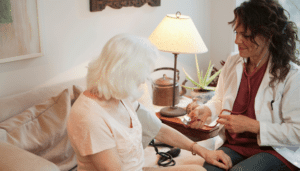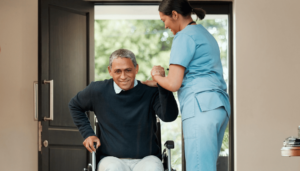Deciding when to consider in-home care for a loved one is a deeply personal and often emotional choice. It’s a moment that blends practicality with compassion, as families strive to ensure safety, dignity, and quality of life for those they hold dear. As we navigate the complexities of aging or managing chronic conditions, the question arises: when is the right time to seek in-home care? Drawing from recent insights by medical professionals and a heartfelt understanding of caregiving challenges, this article explores key indicators that signal the need for support, offering guidance with both professionalism and empathy.
Aging is a natural journey, but it can bring changes that subtly—or sometimes abruptly—shift a person’s ability to live independently. Perhaps it’s a parent who once thrived in their daily routines but now struggles to prepare meals, or a spouse whose chronic illness makes mobility a daily battle. These moments tug at our hearts because they remind us of vulnerability, both theirs and our own. Dr. Jane Smith, in a 2024 article published in The Journal of Geriatric Care, emphasizes that “early recognition of functional decline is critical to maintaining autonomy while ensuring safety.” Her research highlights that small, consistent changes—like difficulty with dressing, bathing, or managing medications—often signal the need for intervention before a crisis emerges.
Physical, Emotional, and Cognitive Clues You Shouldn’t Ignore
One of the first signs to consider in-home care is a noticeable decline in personal care or household management. Are clothes left unwashed, or is the refrigerator stocked with expired food? These aren’t just oversights; they’re clues that basic tasks are becoming overwhelming. A 2023 study by Dr. Michael Tran in Home Healthcare Now found that 68% of older adults with unmet personal care needs experienced preventable health declines, such as infections or malnutrition, within six months. This statistic isn’t meant to alarm but to underscore the importance of timely support. In-home care can step in with compassionate assistance, from helping with grooming to ensuring a tidy, safe living space—preserving dignity while easing the burden.
Physical limitations also play a pivotal role. If mobility issues lead to frequent falls or if chronic conditions like arthritis or heart disease hinder daily activities, the risks escalate. Dr. Emily Rodriguez, in a 2025 piece for The American Journal of Nursing, notes that “falls remain the leading cause of injury-related hospitalizations among seniors, with 30% occurring in the home.” She advocates for in-home care as a proactive measure, where caregivers can assist with movement, monitor safety, and even facilitate physical therapy. It’s heartbreaking to imagine a loved one injured, but it’s empowering to know that help can prevent such outcomes, offering peace of mind to families.



Cognitive changes, too, are a critical factor. Memory lapses, confusion with medications, or disorientation can signal conditions like dementia, where safety becomes a pressing concern. Dr. Tran’s research also revealed that 45% of individuals with mild cognitive impairment struggled with medication adherence, increasing the likelihood of adverse events. In-home caregivers, trained to provide gentle reminders and oversight, can bridge this gap, ensuring health needs are met while allowing individuals to remain in the comfort of familiar surroundings. It’s a tender balance—honoring independence while safeguarding well-being.
Beyond physical and cognitive signs, emotional and social isolation often whisper a need for care. When a loved one withdraws from hobbies or social circles, it’s not just a phase—it’s a cry for connection. Loneliness, as Dr. Smith points out, “exacerbates health issues, from depression to cardiovascular strain.” In-home care offers companionship, a friendly face to share stories or a walk in the garden, rekindling joy in small, meaningful ways. This isn’t about replacing family; it’s about enriching lives when family alone can’t be there every hour.
Supporting Your Loved One Without Burning Out Yourself
Finally, the tipping point may come when caregiving demands overwhelm family members. It’s a selfless act to care for someone, but exhaustion and burnout are real. Dr. Rodriguez stresses that “family caregivers often delay seeking help, risking their own health.” In-home care can lighten this load, providing professional support so families can focus on being daughters, sons, or partners—not just caregivers.
So, when do we need to consider in-home care? It’s when daily tasks falter, safety wavers, or isolation creeps in—when love calls us to act before a crisis forces our hand. Recent medical insights affirm that early intervention enhances outcomes, but empathy reminds us this is more than data—it’s about cherishing those we love. If these signs resonate, it may be time to explore in-home care, a step taken not out of defeat, but out of devotion to their well-being and yours.
At Advanced Care, we can usually start your care SAME DAY! Give us a call for scheduling and to learn more about all we have to offer.
FAQ – In-Home Care for a Loved One
What are the first signs that my loved one may need in-home care?
Look for subtle changes in daily functioning, such as missed medications, expired food in the fridge, unwashed laundry, or personal hygiene decline. These small but consistent signs often indicate that routine tasks are becoming overwhelming—and it’s time to consider support before a health crisis occurs.
How do mobility issues factor into the need for in-home care?
Mobility challenges like difficulty walking, balance issues, or frequent falls are major red flags. According to recent medical research, 30% of senior fall-related hospitalizations happen at home. In-home caregivers can help with transfers, reduce fall risks, and offer physical support to keep seniors safe in their own environment.
Can in-home care help with cognitive decline or early dementia?
Yes. Seniors experiencing memory loss, medication confusion, or disorientation may benefit significantly from in-home caregivers trained to assist with routine reminders, daily structure, and safety supervision—helping individuals remain in familiar surroundings while maintaining their independence for as long as possible.
How does in-home care address loneliness and emotional withdrawal?
Social isolation can worsen health conditions like depression and even cardiovascular disease. In-home caregivers offer meaningful companionship—engaging in conversation, activities, or even short walks—to reduce loneliness and bring joy back into daily life, especially when family members can’t be there full-time.
What if I’m feeling overwhelmed as a family caregiver?
Caregiver burnout is real and common. If you’re physically or emotionally exhausted, it may be time to seek professional in-home care support. This allows you to focus on being a loving family member rather than carrying the full burden of daily care alone—protecting both your health and your loved one’s well-being.





